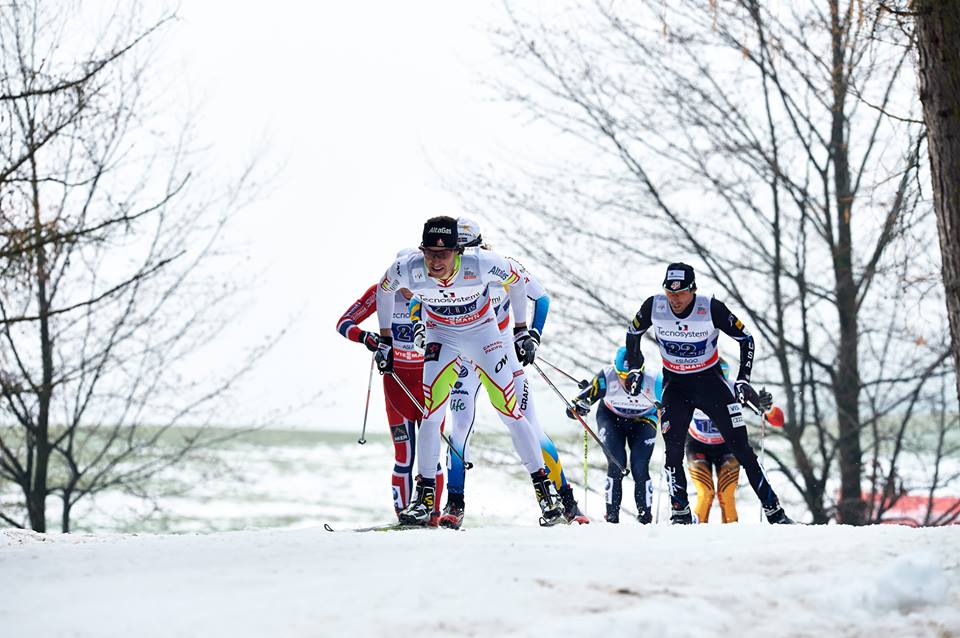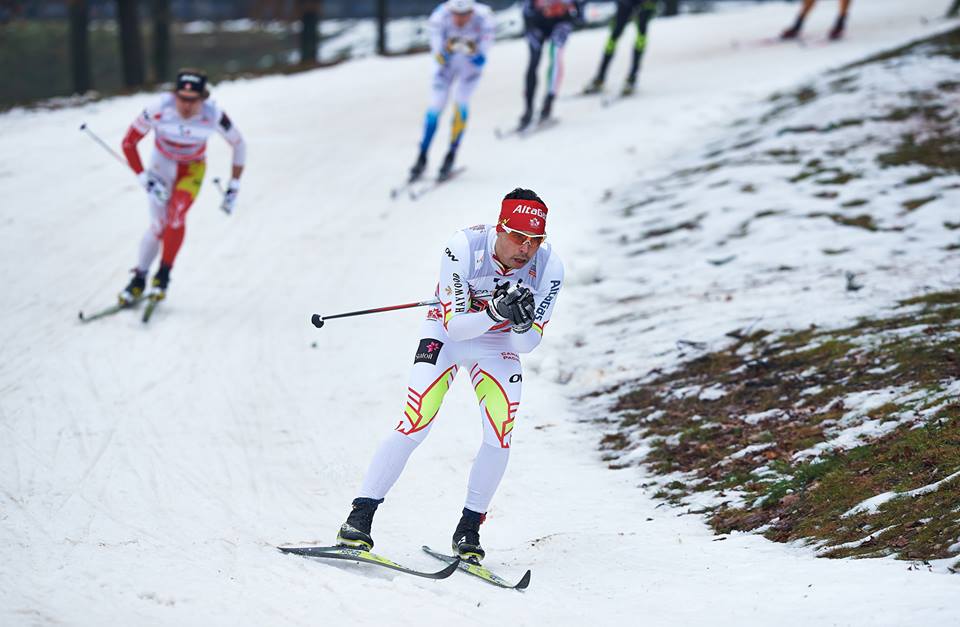
It was a disappointing day in Asiago, Italy, for the U.S. and Canadian men in Sunday’s classic team sprint, with neither team making the 6 x 1.65-kilometer final. Both Canada I, with Devon Kershaw and Alex Harvey, and USA I, with Simi Hamilton and Andy Newell, were in the same semifinal — the second one, which proved disadvantageous on a balmy 41-degree day.
As the temperatures warmed and salted snow became more chewed up, ski times slowed. Only the top three teams from the second men’s semifinal advanced. Canada placed fifth, 6.64 seconds out of qualifying and 8.87 seconds behind Norway II’s Øystein Pettersen and Eirik Brandsdal, who won the heat in 24:53.04 and went on to place third in the final. The Canadians ended up 11th overall.

Germany’s Axel Teichmann and Tim Tscharnke were a second faster in than the Canadians in fourth, missing the cut for the final along with the U.S. in sixth (+9.68), which was 12th overall.
With snow piled about 8-meters wide on a golf course, the 1.65 k loop included many tight turns and challenging transitions to keep the racers on their toes. That wasn’t a problem for guys like Hamilton.
“[It was] a great technical course in my book,” he wrote in an email. “Fun, rolling terrain with lots of tight turns and good transitions. There were no crashes in our race that I know of, but I’m actually pretty surprised by that. I guess there was no real place to build up a lot of speed, so that probably helped.”
Conditions were variable, with the course deteriorating with each passing skier and each passing minute. The decision to salt the course that morning made the track a little faster, according to racers. The firmer snow also made double poling a more efficient choice, as poles don’t punch through the soft snow as much. Nevertheless, the course did not hold up throughout the second semifinal and racers — male and female — had to ski outside the track for the fastest method.
“I think we were at a bit of a disadvantage being randomly seeded into the second semifinal,” Hamilton wrote. “Even though conditions were much better, the course was still breaking down a fair amount each lap it got skied. The fact that five out of the six lucky loser teams came from the first semifinals in both the women’s race and men’s race speaks to this.”
Indeed, variable conditions caused teams to keep all options open for an even higher degree of gamesmanship.
“Teams were really checking each other out and making last-minute decisions depending on what the competition was doing,” Newell wrote in an email about the conundrum of skate vs. classic skis. “It was kind of fun.”
“We had classic skis and skate skis ready to go in our box, thinking I might stride my first leg and then switch to double-pole for the last two laps,” Newell wrote. “But I was feeling strong so I yelled to [my coach] at the last minute to bring out the skate skis before Simi came into the first tag.”

The U.S. team had a strong start, with Hamilton taking an early lead. Newell maintained the position, coming into the second tag less than half a second behind Brandsdal of Norway, but Hamilton slipped to the fifth on the next leg.
“I’m a little disappointed with a tactical decision I made in my second lap,” Hamilton wrote. “My thought going in to the race was that it would be smart to go double pole/stride/double pole so as to give my arms a bit of a rest in between two consecutive 4 min double pole loops. But the course definitely lends itself to being much faster on skate skis and I should have just stuck with double pole for all three of my legs.”
He had a “great start,” setting the pace with Pettersen on the first leg. “On my second leg, I used too much energy trying to stay with the double polers (I ended up double poling about 90% of the lap on my classic skis anyway), and lost valuable energy in that round,” he added.
Newell fought them back into second on his second leg, but Hamilton could not hold the pace and the team slipped again to fifth entering Newell’s anchor leg. He found himself unable to hold the gain back the lost ground, and slipped back one more spot to sixth place after being passed by Canada’s Alex Harvey.
“Norway, Kazakhstan and Sweden had [pulled ahead at this point,] with Canada, Germany, and us chasing,” Newell continued. “Before the exchange I told Harvey we needed to push the pace hard in order to … just try to get the time down in order to make [lucky loser]. I tried to set a fast pace, leading Germany and Canada for most of the lap, but it wasn’t quite enough.”
Harvey was disappointed to not make the final, but felt good about his personal performance with the first-, third- and second-fastest lap times.
“I had a good day … it was a pretty solid outing,” he wrote in a message. “The track was slowing down quite a bit, so it was pretty hard to qualify as a lucky loser out of the 2nd semifinal heat. [I’m] a bit bummed out to not make the final, but personally I took a lot of confidence out of the weekend.”
Harvey had the 13th-fastest qualifying time in Saturday’s individual classic sprint before being disqualified for skating on his skate skis. On Sunday, Harvey and Kershaw used classic skis for the first leg and skate skis for the next two, on the logic that they could stay with the double-polers for the first leg while saving their arms for the final two legs.
Harvey and Kershaw are the defending classic-team sprint world champions (from 2011) and placed fourth in the freestyle event at 2013 World Championships last season.
Kershaw started them off Sunday by tagging in eighth, and Harvey turned in a fast lap to bump them into third, making what he described as a “good move” on the main climb. Kershaw slipped back one place on the next leg to the fourth. Harvey fought back, moving the team into first, making yet another “move over the top on the main uphill.”
However, it was not enough, as Kershaw slipped again back to fifth place. But Harvey still felt strong going into the anchor leg.
“[Germany’s] Tim Tscharnke passed me in the last little downhill, but then I got Andy in the final stretch,” he explained. “I still had good energy. I think I had the second best time there so I was happy about that. But I was hoping it would be enough for lucky loser.”
Rounding out the North American finishes, Canada II’s Jess Cockney (Alberta World Cup Academy) and Lenny Valjas placed 13th in the same semifinal (+1:18.8) for 24th overall. USA II’s Torin Koos (Bridger Ski Foundation and Mikey Sinnott (Sun Valley Ski Education Foundation) went from 10th early to 15th in the first semifinal for 28th overall.
Looking Forward to Sochi
Comparing Asiago’s team sprint to the upcoming Olympic classic team sprint in Sochi, Russia, isn’t exactly comparing apples to apples.
“Sometimes the team sprints are tricky because of the changing snow conditions and lucky loser spots,” Newell wrote. “This course isn’t very representative of Sochi, so I think we will have a better shot on a different course with more stable conditions.”
Hamilton explained that the Sochi course includes “two extremely long climbs separated by a couple of really fast downhills,” he wrote. “I think that the Sochi course will be much more straightforward … everyone will be striding (no crazy double pole vs. striding questions to be answered there). I think that with those long climbs, as long as each team member can focus on skiing those hill as well as they can, the race will just come down to pure fitness and pain tolerance. I think today there was a lot of tactics at play, which is always awesome to have in a race, but Sochi will be more straightforward.”
First, he’s looking forward to another World Cup team sprint in Nove Mesto before the Olympics.
The Holidays



